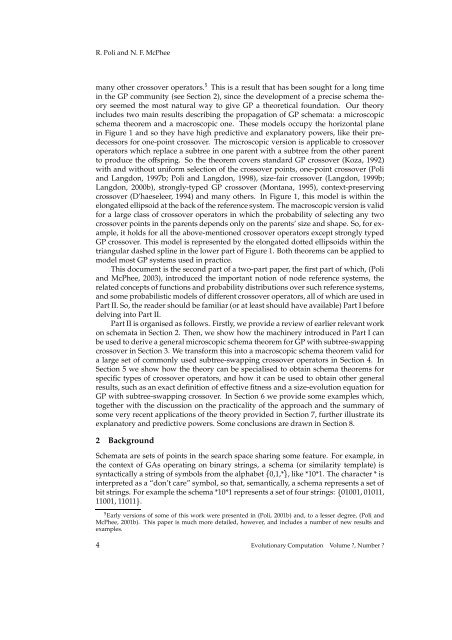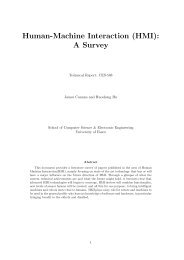General Schema Theory for Genetic Programming with Subtree ...
General Schema Theory for Genetic Programming with Subtree ...
General Schema Theory for Genetic Programming with Subtree ...
Create successful ePaper yourself
Turn your PDF publications into a flip-book with our unique Google optimized e-Paper software.
R. Poli and N. F. McPhee<br />
many other crossover operators. 5 This is a result that has been sought <strong>for</strong> a long time<br />
in the GP community (see Section 2), since the development of a precise schema theory<br />
seemed the most natural way to give GP a theoretical foundation. Our theory<br />
includes two main results describing the propagation of GP schemata: a microscopic<br />
schema theorem and a macroscopic one. These models occupy the horizontal plane<br />
in Figure 1 and so they have high predictive and explanatory powers, like their predecessors<br />
<strong>for</strong> one-point crossover. The microscopic version is applicable to crossover<br />
operators which replace a subtree in one parent <strong>with</strong> a subtree from the other parent<br />
to produce the offspring. So the theorem covers standard GP crossover (Koza, 1992)<br />
<strong>with</strong> and <strong>with</strong>out uni<strong>for</strong>m selection of the crossover points, one-point crossover (Poli<br />
and Langdon, 1997b; Poli and Langdon, 1998), size-fair crossover (Langdon, 1999b;<br />
Langdon, 2000b), strongly-typed GP crossover (Montana, 1995), context-preserving<br />
crossover (D’haeseleer, 1994) and many others. In Figure 1, this model is <strong>with</strong>in the<br />
elongated ellipsoid at the back of the reference system. The macroscopic version is valid<br />
<strong>for</strong> a large class of crossover operators in which the probability of selecting any two<br />
crossover points in the parents depends only on the parents’ size and shape. So, <strong>for</strong> example,<br />
it holds <strong>for</strong> all the above-mentioned crossover operators except strongly typed<br />
GP crossover. This model is represented by the elongated dotted ellipsoids <strong>with</strong>in the<br />
triangular dashed spline in the lower part of Figure 1. Both theorems can be applied to<br />
model most GP systems used in practice.<br />
This document is the second part of a two-part paper, the first part of which, (Poli<br />
and McPhee, 2003), introduced the important notion of node reference systems, the<br />
related concepts of functions and probability distributions over such reference systems,<br />
and some probabilistic models of different crossover operators, all of which are used in<br />
Part II. So, the reader should be familiar (or at least should have available) Part I be<strong>for</strong>e<br />
delving into Part II.<br />
Part II is organised as follows. Firstly, we provide a review of earlier relevant work<br />
on schemata in Section 2. Then, we show how the machinery introduced in Part I can<br />
be used to derive a general microscopic schema theorem <strong>for</strong> GP <strong>with</strong> subtree-swapping<br />
crossover in Section 3. We trans<strong>for</strong>m this into a macroscopic schema theorem valid <strong>for</strong><br />
a large set of commonly used subtree-swapping crossover operators in Section 4. In<br />
Section 5 we show how the theory can be specialised to obtain schema theorems <strong>for</strong><br />
specific types of crossover operators, and how it can be used to obtain other general<br />
results, such as an exact definition of effective fitness and a size-evolution equation <strong>for</strong><br />
GP <strong>with</strong> subtree-swapping crossover. In Section 6 we provide some examples which,<br />
together <strong>with</strong> the discussion on the practicality of the approach and the summary of<br />
some very recent applications of the theory provided in Section 7, further illustrate its<br />
explanatory and predictive powers. Some conclusions are drawn in Section 8.<br />
2 Background<br />
<strong>Schema</strong>ta are sets of points in the search space sharing some feature. For example, in<br />
the context of GAs operating on binary strings, a schema (or similarity template) is<br />
syntactically a string of symbols from the alphabet ¡ 0,1,*¢ , like *10*1. The character * is<br />
interpreted as a “don’t care” symbol, so that, semantically, a schema represents a set of<br />
bit strings. For example the schema *10*1 represents a set of four strings: ¡ 01001, 01011,<br />
11001, 11011¢ .<br />
5 Early versions of some of this work were presented in (Poli, 2001b) and, to a lesser degree, (Poli and<br />
McPhee, 2001b). This paper is much more detailed, however, and includes a number of new results and<br />
examples.<br />
4 Evolutionary Computation Volume ?, Number ?




